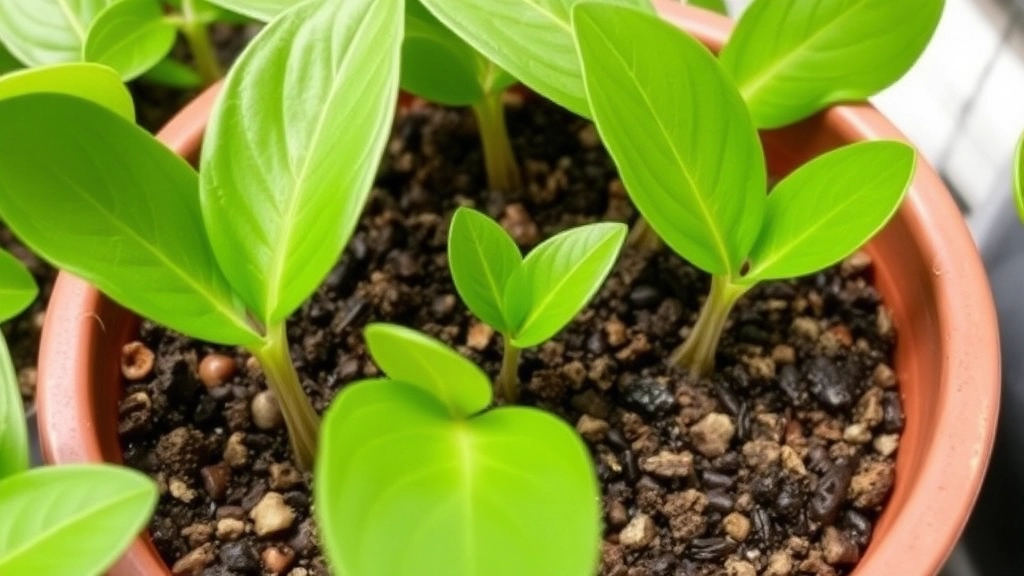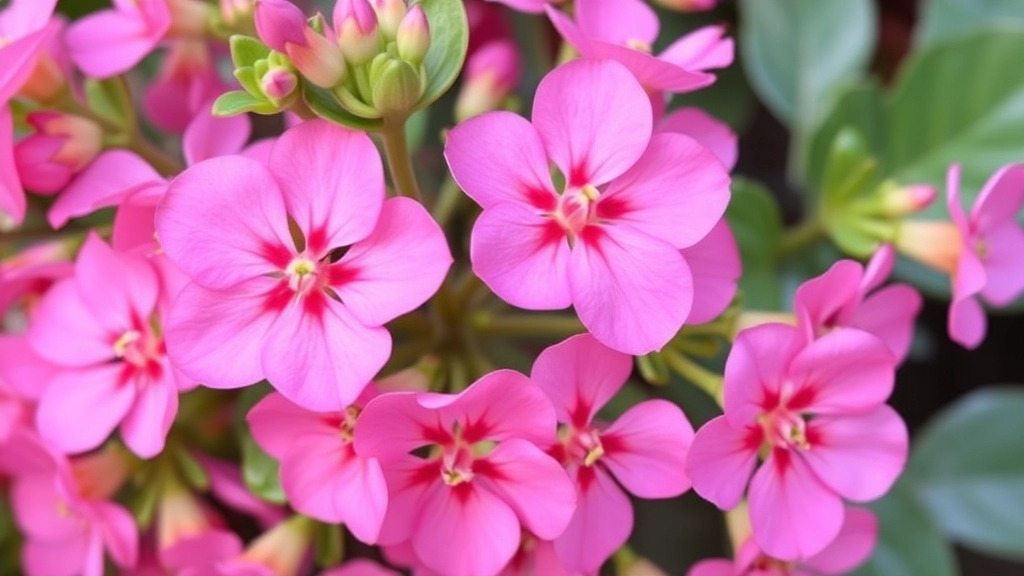Kalanchoe Pink Flowers: A Vibrant Choice
When it comes to vibrant and eye-catching succulents, Kalanchoe Pink Flowers are a top choice. These stunning plants, particularly the Kalanchoe ‘Pink Butterflies,’ captivate with their vivid pink hues and unique variegation. If you’re eager to add this beauty to your collection, understanding its characteristics and care requirements is essential.
Successful Growth of Kalanchoe Pink Flowers
Growing Kalanchoe Pink Flowers successfully involves knowing the best practices for both indoor and outdoor settings. From optimal watering and fertilization techniques to effective propagation methods, mastering these tips will ensure your plant thrives. Additionally, being aware of common pests and diseases, along with seasonal maintenance, will keep your Kalanchoe blooming year-round.
When considering indoor plants, many of us seek options that are not only beautiful but also easy to care for.
Kalanchoe ‘Pink Flowers’ stands out as a stunning choice.
This succulent is adored for its vibrant, pink blooms that can brighten any space.
Key Characteristics:
– **Foliage:** Thick, fleshy leaves that are usually a deep green, providing a robust backdrop for the flowers.
– **Blooms:** Clusters of small, star-shaped flowers that bloom in shades of pink, often appearing in late winter to early spring.
– **Growth Habit:** Compact and bushy, making it ideal for small spaces or as a tabletop plant.
– **Size:** Typically reaches a height of about 30-45 cm (12-18 inches), making it a manageable size for indoor settings.
– **Light Requirements:** Prefers bright, indirect sunlight but can tolerate some direct sun.
– **Temperature Tolerance:** Thrives in temperatures between 15-25°C (59-77°F), making it suitable for most indoor environments.
These characteristics not only make Kalanchoe ‘Pink Flowers’ visually appealing but also a practical addition to your plant collection. For those looking to expand their collection, check out the [best varieties and prices of Kalanchoe succulents](https://planthq.org/kalanchoe-succulent-for-sale-best-varieties-prices/). Additionally, if you’re interested in learning more about the care of another popular variety, read our [guide on Kalanchoe Tomentosa care](https://planthq.org/succulent-kalanchoe-tomentosa-care-tips-and-growing-guide/).
Best Practices for Growing Kalanchoe Indoors and Outdoors

So, you’ve got your eye on Kalanchoe ‘Pink Flowers,’ and you want to make sure it thrives, right?
Indoor Growing Tips
- Light Requirements: Kalanchoe loves bright, indirect sunlight. A south-facing window is ideal, but too much direct sun can scorch those lovely leaves.
- Temperature: Keep it cozy! Kalanchoe prefers temperatures between 18°C to 24°C. Avoid drafts and sudden temperature changes.
- Soil Choice: Use a well-draining potting mix. A cactus mix works wonders or you can mix regular potting soil with sand.
- Pot Selection: Choose pots with drainage holes to prevent root rot. Terracotta pots are a great choice as they allow moisture to escape.
Outdoor Growing Tips
- Sunlight: Outdoors, Kalanchoe thrives in full sun. Aim for at least 6 hours of sunlight daily.
- Climate Considerations: Ideal for warmer climates (USDA zones 10-11). If you live in a cooler area, bring it indoors when temperatures drop.
- Soil and Drainage: Again, go for well-draining soil. Raised beds or containers can help with drainage.
- Watering: Water sparingly. Let the soil dry out between waterings, especially in cooler months.
When it comes to nurturing Kalanchoe ‘Pink Flowers’, understanding watering and fertilization is essential for achieving those vibrant blooms. Many plant enthusiasts often worry about how much water their plants truly need.
## Watering Guidelines
– **Frequency**: Water your Kalanchoe when the top inch of soil feels dry. Typically, this means watering every 1-2 weeks, depending on the season.
– **Method**: Use the soak-and-dry method. Water thoroughly until it drains from the bottom, then let the soil dry out before the next watering.
– **Signs of Overwatering**: Yellowing leaves or a mushy stem indicate too much water. Adjust your routine if you notice these signs.
– **Signs of Underwatering**: If the leaves start to wrinkle or shrivel, it’s time to give your plant a drink.
## Fertilization Tips
Fertilizing your Kalanchoe properly can significantly enhance blooming.
– **Type of Fertilizer**: Use a balanced, water-soluble fertilizer with a ratio like 20-20-20 during the growing season (spring and summer).
– **Frequency**: Fertilize every 4-6 weeks when the plant is actively growing. Reduce or stop fertilizing in the fall and winter when growth slows.
– **Dilution**: Always dilute the fertilizer to half the recommended strength to avoid burning the roots.
By following these watering and fertilization techniques, you’ll set your Kalanchoe ‘Pink Flowers’ up for a spectacular display of blooms. For more detailed care instructions, check out our guide on [Kalanchoe Succulent Pink Care](https://planthq.org/kalanchoe-succulent-pink-care-growth-propagation-guide/) and learn about the [Ultimate Guide to Growing and Caring for Succulent Plant Kalanchoe](https://planthq.org/ultimate-guide-to-growing-and-caring-for-succulent-plant-kalanchoe/).
Propagation Methods: Growing New Plants from Leaf Plantlets

Are you looking to expand your Kalanchoe collection without spending a fortune?
Propagation through leaf plantlets is an effective and rewarding method that allows you to grow new plants from your existing Kalanchoe ‘Pink Flowers’.
Why Choose Leaf Plantlets?
- Cost-Effective: You can multiply your plants without purchasing new ones.
- Simplicity: The process is straightforward and suitable for beginners.
- Rapid Growth: Leaf plantlets can root quickly, leading to new blooms sooner than you might expect.
Steps for Propagating Kalanchoe from Leaf Plantlets
- Select Healthy Leaves:
- Choose mature leaves that are free from disease or damage.
- Look for plump, healthy leaves, as they have the best chance of rooting.
- Prepare the Leaves:
- Gently twist or cut the selected leaves from the stem.
- Allow the cut ends to dry for a few hours. This helps to prevent rot.
- Planting the Leaves:
- Use a well-draining potting mix, ideally a cactus or succulent mix.
- Place the dried cut end of the leaf into the soil, burying it slightly.
- Watering:
- Lightly mist the soil to moisten it but avoid soaking.
- Ensure the pot has drainage holes to prevent waterlogging.
- Create the Right Environment:
- Place the pot in a warm, bright location but out of direct sunlight.
- Maintain a temperature between 18-24°C (65-75°F) for optimal growth.
- Patience is Key:
- Roots may take a few weeks to develop; be patient and check for signs of new growth.
- Once you see new plantlets forming, you can treat them as you would a mature Kalanchoe.
Tips for Success
- Humidity: If your environment is dry, consider using a plastic bag to create a mini greenhouse effect.
- Fertilization: Once the plantlets are established, a diluted succulent fertilizer can encourage growth.
Common Issues and How to Address Pests and Diseases
As we delve deeper into the care of Kalanchoe ‘Pink Flowers’, it’s essential to be aware of potential pests and diseases that can disrupt their vibrant growth.
### Seasonal Maintenance for Year-Round Health and Blooming
So, you’ve got your Kalanchoe ‘Pink Flowers’ thriving, but how do you keep it looking fabulous throughout the year? Seasonal maintenance is key to ensuring your plant not only survives but flourishes.
#### Spring: Time to Refresh
When spring rolls around, it’s the perfect time to give your Kalanchoe a little love.
FAQs on Growing Kalanchoe ‘Pink Flowers’
What are the light requirements for Kalanchoe ‘Pink Flowers’ when grown indoors?
Kalanchoe ‘Pink Flowers’ thrives in bright, indirect sunlight. A south-facing window is ideal, but avoid too much direct sun to prevent scorching the leaves.
What temperature range is best for Kalanchoe ‘Pink Flowers’?
Keep your Kalanchoe cozy with temperatures between 18°C to 24°C. Avoid drafts and sudden temperature changes for optimal growth.
What kind of soil should I use for Kalanchoe ‘Pink Flowers’?
Use a well-draining potting mix. A cactus mix works wonders, or you can mix regular potting soil with sand for better drainage.
Can Kalanchoe ‘Pink Flowers’ be grown outdoors?
Yes, Kalanchoe ‘Pink Flowers’ can be grown outdoors, especially in warmer climates (USDA zones 10-11). Ensure it gets at least 6 hours of sunlight daily and use well-draining soil.
How often should I water my Kalanchoe ‘Pink Flowers’?
Water sparingly and let the soil dry out between waterings. This is particularly important in cooler months to prevent root rot.
What is the best method to propagate Kalanchoe ‘Pink Flowers’?
Propagation through leaf plantlets is effective and rewarding. It’s cost-effective, simple, and leads to rapid growth.
How do I select leaves for propagating Kalanchoe ‘Pink Flowers’?
Choose mature, healthy leaves that are free from disease or damage. Plump, healthy leaves have the best chance of rooting.
What steps should I follow to prepare leaves for propagation?
Gently twist or cut the selected leaves from the stem and allow the cut ends to dry for a few hours to prevent rot.
How should I plant the leaves for propagation?
Use a well-draining potting mix, ideally a cactus or succulent mix. Place the dried cut end of the leaf into the soil, burying it slightly.
How should I water the propagated leaves?
Lightly mist the soil to moisten it but avoid soaking. Ensure the pot has drainage holes to prevent waterlogging.
What environment is ideal for propagating Kalanchoe ‘Pink Flowers’?
Place the pot in a warm, bright location but out of direct sunlight. Maintain a temperature between 18-24°C (65-75°F) for optimal growth.
How long does it take for Kalanchoe ‘Pink Flowers’ to root and grow?
Roots may take a few weeks to develop. Be patient and check for signs of new growth. Once you see new plantlets forming, treat them as mature Kalanchoe.
Are there any tips for ensuring successful propagation?
If your environment is dry, consider using a plastic bag to create a mini greenhouse effect. Once the plantlets are established, a diluted succulent fertilizer can encourage growth.
References
-
Growing Kalanchoe: Tips and Tricks
-
Kalanchoe Plant Profile
-
Kalanchoe Care: How to Grow Kalanchoe Plants
